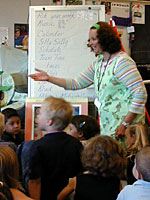By Tim Pugmire
Minnesota Public Radio
September 5, 2002
Students enrolled in financially-troubled school districts are feeling the consequences of recent budget cuts. Many schools reopened with fewer teachers, larger class sizes and higher activity fees.
| |
|
|
|
||
At Park View Early Childhood Center in Champlin, recess helps break up the long school day for kindergarten students, who now attend a full six hours a day, every other day.
The Anoka-Hennepin School District abandoned the half-day, every day schedule for kindergarten this year as a way to reduce transportation costs. Principal Rolf Carlson says the change was hard.
"On the surface it looks like same amount of time for kids in school, so no big deal. We saved a million bucks without disrupting anything. And that's not true," he says. "It definitely calls for quite a shift, and we were quick to point out some of those concerns. But I think we've also gotten on board and saying, 'hey we'll make this great for all the kids involved, and this is our reality, here we go.'"
For teacher Susan Nordby, the new schedule means a new approach in the classroom to keep five year olds engaged for a full day. Nordby says she's concerned about students retaining what they've learned over their days off, but she also sees some benefits to the new schedule.
"I'm really looking forward to more time with students, because it seemed in a half-day program you really had to make critical choices about what gets left out. So. I'm really looking forward to having a more leisurely day, interacting with students more socially and not having to be like on a tread mill for the students during their day in school," Nordby says.
| |
|
|
|
||
Most of the $10 million cut from the Anoka-Hennepin school district budget this year was largely kept away from classrooms. District officials increased fees, cut programs and eliminated free bus rides for students living within two miles of school. They can still ride the bus if they pay an annual fee.
Several Twin Cities districts made similar reductions this year to solve large budget shortfalls. The cuts totaled $32 million in Minneapolis, $20 million in St. Paul and $15 million in Osseo. Class sizes are also bigger. An estimated 1,400 teaching positions were eliminated statewide.
Scott Croonquist of the Association of Metropolitan School Districts says staff reductions are unavoidable for financially-strapped districts.
"They don't produce a product. They don't manufacture anything. What they do, of course, is teach, and so the resources are tied up in teachers and human capital. If you have to make significant reductions, the bottom line is reductions have to be made in the area of staffing," according to Croonquist.
At Tartan High School in Oakdale, enrollment is up about 150 students from last year. But district budget cuts claimed three teaching positions. Principal Clete Lipetzky says average class sizes will be well over 30 students.
| |
|
|
|
||
"With what we gained in enrollment, we should have picked up four teachers, and we wound up losing about three. So we feel we're seven teachers short of where we were a year ago," Lipetzky says.
Officials in the North St. Paul-Maplewood-Oakdale school district cut a total of 39 teachers as part of $6.7 million in budget cuts. They also increased various fees. Students in sports are paying nearly double what they paid last year. At Tartan, participation in fall athletics is down 15 percent.
Dan Chapman, a senior on the cross country team, says he knows a lot of students who weren't willing to pay the $154 fee.
"A lot of people have to pay for it themselves. Their parents won't pay for it. So, they just don't want to go through the trouble of having to spend more money. And if they're doing three sports,it gets harder too," Chapman says.
Coaches and administrators at Tartan say they hope to see more affordable participation fees and smaller classes next year if district voters approve a operating levy in November. Last fall's ballot question failed by 152 votes.
Officials in more than a dozen metro-area districts that slashed budgets this year are going back to voters for additional taxpayer support.
More from MPR


